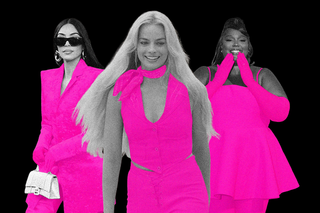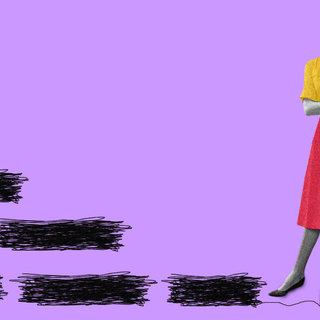
The ‘Barbiecore’ Aesthetic Shows How Reclamation Isn’t Always Subversive
A new aesthetic trend inspired by the cultural resurgence of Barbie claims to be reclaiming pink and girliness, but may just be participating in commodifying them even further.

It’s been nearly two years in the making, but it’s finally happened — hot pink and glitter are back, fashion would have us note. Red carpets and runways are awash in the bright, block monochrome that many have been eager to tout as unambiguously feminist. It’s fun, flirty, sexy, bold, and confident — and most importantly, it’s girly. But we’re reclaiming girliness now, which makes “Barbiecore” liberating in a way that it wouldn’t have been two decades ago.
Barbiecore is touted as one that subverts the association of femininity with docility. Pink is the new frontier of asserting a new kind of hyper–femininity that’s out, loud, and proud. Where it used to signify submissiveness and an oppressive kind of niceness, the same color now signifies independence, sexuality, confidence, and charisma — it’s to make a statement about the changing norms around femininity. It even subverts the idea of the “bimbo” as ‘Barbiecore’ becomes interchangeable with ‘bimbocore’ — a call-back to the cultural opinion about Paris Hilton in the early aughts. Now, bimbocore is something to reclaim, as we’ve thoroughly debunked the word itself. So far so good — indeed, Lil Nas X and Harry styles have also embraced the aesthetic and given it a more subversive sheen.
But when an entire aesthetic is all but forced upon us as feminist, empowering, and necessary — moreover, requiring one to fill up their shopping carts with stuff to embody it — is it really liberating? The fact remains that a majority of the people ‘reclaiming’ Barbiecore remain conventionally attractive celebrities and high fashion houses. Kim Kardashian, for one, is credited with bringing the aesthetic into mainstream relevance — and yet she is simultaneously known for her near-constant body modifications that give her the impossible proportions of Barbie herself, besides also promoting snake oil-like diet pills and teas.
The trend has really came into its own with Margot Robbie playing the eponymous character in feminist filmmaker Greta Gerwig’s Barbie. The film may be a satirical or even subversive take on the Barbie phenomenon, but the Internet nevertheless fawned over images of Robbie clad in a hot-pink cowgirl attire. This, notwithstanding the fact that Robbie is still a thin, cis, blonde-haired, blue-eyed woman considered to be among the most beautiful women in the world already. Arguably, this set of features still represents oppressive beauty norms when beauty is constantly changing and getting more diverse — forming the bedrock of what societal expectations around beauty aspire to in some form or another.
Related on The Swaddle:
Maker of Barbie Tries Its Hand at Feminism, and Fails
In trying to reclaim and even subvert what Barbie represents, the Barbiecore aesthetic ends up falling into the same trap as the original and controversial doll itself: it cannot exist without mass production, hyper-optimization, and commodification. Barbie herself is a complex cultural phenomenon — she’s received more progressive upgrades than most other toys and is a testament to the longevity of culture-sensitive branding. But she also represents the worst excesses of capitalism, in which progressive ideas are co-opted into sanitized, sellable objects. Take the fact that despite representing more professions than women themselves have been in (Barbie has been the U.S President) and more skin-tones than before, she still retains her core essence of sweetness, mostly Eurocentric beauty — with just enough of an upgrade as to be pleasing but never discomforting.
The Barbiecore aesthetic is similar: it is sameness masquerading as difference. It is mass-produced — this time on the algorithmic assembly line — and, importantly, it sells not just pink but also a value-system that makes the pink more delicious. It doesn’t matter who embraces the aesthetic (the more diverse the better for the brands) — as long as the aesthetic is embraced. Worse still, it borrows (without credit) from drag culture, where the aesthetic was truly subversive and gender-bending. In comparison, Barbiecore remains boring in its insistence that it’s not.
In the meantime, the insistence on redefining beauty has walked us back on whatever progress we made in questioning it all ttogether. During the pandemic, we began to ditch some ideals in favor of newer ones that prioritized physical comfort and greater acceptance. “But moving away from existing ideals, and accepting newer ones as ‘also beautiful’, runs the risk of falling prey to the same cycle, in which one beauty norm just replaces another while beauty itself remains the goal,” Devrupa Rakshit noted in The Swaddle earlier.
Moreover, mainstream, pop-ified aesthetics like Barbiecore are never as exhaustive as they present themselves to be: “However hard we try to cram more into the definition of beauty, we’re always going to leave something behind,” as Rajvi Desai wrote for The Swaddle earlier.
In the end, no matter how much it says otherwise, the Barbiecore aesthetic is just that — an aesthetic. In its insistence that pink is now empowering, it still slaps the color onto the kinds of uncomfortable hyper-feminine fashion that we’ve just begun to question. High heels, lingerie, long nails, sunglasses, tiny purses, and bandage dresses have all, at various points in time, been regarded as oppressive for the ways that they became essential to expressing femininity — as if that was all there was to being feminine. But now we’re back to reclaiming these same things that, at the end of the day, line the pockets of the retail, wellness, and beauty megaliths who have the most to gain from it.
Rohitha Naraharisetty is a Senior Associate Editor at The Swaddle. She writes about the intersection of gender, caste, social movements, and pop culture. She can be found on Instagram at @rohitha_97 or on Twitter at @romimacaronii.
Related


The Buzz Cut: Celebrity Couple Reunites and Marries, Prompting Global ‘Text Your Ex’ Crisis
